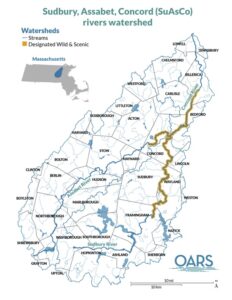Who is a member?
Our members are the local governments of Massachusetts and their elected and appointed leadership.

A new regional collaborative will focus on climate resiliency for the Sudbury, Assabet, and Concord rivers watershed. (Map courtesy of Metropolitan Area Planning Council/OARS 3 Rivers)
The town of Concord is joining forces with the Metropolitan Area Planning Council and watershed organization OARS 3 Rivers to launch a regional climate collaborative for the Sudbury, Assabet and Concord (SuAsCo) rivers watershed, which covers 399 square miles in 36 municipalities.
The project will build new relationships and enhance existing ones, and each entity has a distinct role. Concord is the grant administrator and fiscal agent. OARS 3 Rivers will lead engagement, communications and coordination across the watershed communities. And MAPC will provide technical planning, facilitation and regional analysis.
The effort has been awarded a $450,000 action grant through the state’s Municipal Vulnerability Preparedness program.
“We are worrying about a lot of things,” said Concord Deputy Town Manager Megan Zammuto. “Drought frequency is increasing. We have lower river flows, which can lead to greater wildfire risk. Our stormwater systems are strained by heavier precipitation and aging infrastructure. Our infrastructure, regionally, was really designed for rainfall patterns of 40 to 100 years ago, and it’s really outdated for what we’re experiencing today. And we can see some lower water quality when we have warmer water temperatures. So it’s the flooding and the droughts and all that comes with it.”
Van Du, environmental planning director at the MAPC, said the team will be building resiliency components that support the population living and working in the watershed area.
“There are different environmental justice communities across the watershed as well,” Du said. “And those are the communities, the populations or the neighborhoods that are disproportionally being impacted by these natural climate threats.”
The two-year project will have three phases. The first is public engagement and outreach to build broad participation and relationships among the watershed communities. Then the team will develop a regional work plan that will identify priorities and shared actions. In the third, technical phase, the team will analyze what would guide future planning and implementation. A steering committee is being put together, and work has begun on the first phase.
“We’re not building this collaborative from ground zero,” said Du. “There is a lot of really great work already happening across municipalities and the watershed. This is an opportunity to foster those relationships among municipalities.”
The watershed is a tributary of the Merrimac watershed, which in turn flows to the Atlantic. Some of the outer towns in the watershed also share boundaries with other watersheds, according to Heather Conkerton, ecological restoration coordinator at OARS 3 Rivers. The SuAsCo also has one of the four federally designated Wild and Scenic areas in the state, a total of 29 miles of river within the watershed.
“It’s really important because in order to be wild and scenic, you have to be federally designated and you can’t have any barriers at all,” Conkerton said. “So if you were to look at a map, you’d actually see that there were no impediments, there are no dams, and the designation stops where the dams start.”
Conkerton said the team will be looking to reach all age and demographic groups, including young voices.
“We need to make sure that we have youth representatives because honestly, that is who’s going to be affected the most,” Conkerton said. “These youth … are our senators, representatives and residents of tomorrow.”
Something learned from existing climate collaboratives, Du said, is that conversations and relationship-building is key to getting buy-in from residents on goals and priorities to then be able to build resources. The team will be holding community meetings and focus groups and building a project website.
“Climate projects can be costly, and flood and drought, they don’t just stop at the municipal boundary or borders,” Du said.
Du and Zammuto said the regional nature of the project made their MVP grant application more competitive, as did their inclusive outreach model.
“Focusing on regional partnerships is kind of the direction we’re going, especially when it comes to climate issues,” Zammuto said. “It really maximizes resources.… We’re not solving all of these things on our own.”